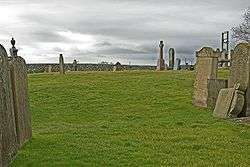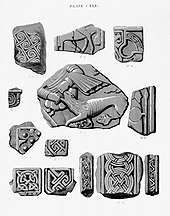Kinneddar Castle
Kinneddar Castle in Moray, Scotland was the residence (or Bishop's Palace) of the bishops of Moray from c.1187 and whose first documented incumbent was Bishop Richard (1187–1203). Very little of the structure now remains but the site is protected as a scheduled ancient monument.[1]

History
Pictish monastic site

Kinneddar was one of the major ecclesiastical centres of the Picts, with radiocarbon dating showing activity on the site from the 7th century through to its first appearance in documentary records in the 12th century,[2] and possible activity as early as the late 6th century.[3] The site was surrounded by vallum ditches first cut during the 7th century[3] enclosing an area of 8.6 hectares[4] – the largest such enclosure discovered within the territory of Northern Pictland.[5] Within the enclosure there is evidence of significant settlement and industry,[3] including a smithing hearth and evidence of ironworking,[6] and the postholes of large wooden roundhouses.[7] Annex enclosures to the south of the main enclosure and dating to the 11th and 12th centuries suggest that the site grew in size and importance over time.[4]
The scale and layout of the site is very similar to that of Iona Abbey, suggesting that the establishment of Kinneddar may have been connected with the church of Columba.[8]
Kinneddar was the source of an important collection of carved Pictish stones, the 32 fragments representing parts of ten cross-slabs, three free-standing crosses and at least eight panels from stone shrine-chests.[9] Some of the sculpture is unfinished showing that it was produced on-site.[10] The stones are decorated with patterns including knotwork and ring-headed crosses, but also include several illustrating human figures such as horse-riders and warriors with spears, and one Class I stone decorated with a crescent and V-rod pattern.[11] Particularly significant is the carving on a fragment of a panel representing the biblical King David wrenching open the jaws of a lion. This is similar to the decoration on the more complete St Andrews Sarcophagus from St Andrews Cathedral and is likely to have contained the body or relics of a king or important saint.[11] David was an imperial symbol closely associated with royal power and this iconography indicates that Kinneddar was a focus for extensive royal patronage, perhaps linked to nearby Burghead Fort.[12]
The Pictish sculptures found in the vicinity of the castle and kirkyard point to the area being an important 8th century Christian centre (see Culdees) and may have been a principal location for the conversion of the Picts.[13]
Bishop's Palace
Bishop Archibald enlarged or rebuilt the castle in c. 1280 and it continued to be used by the bishops until the late 14th century.[14][15] Nothing now exists of the castle except one fragment of a rubble wall that is integrated into the Kinneddar kirkyard boundary wall.[16] Loch Spynie, then open to the sea and much larger than its present size, came close to the castle and its marshes surrounded the castle enclosure on three sides.[16] The ruinous structure still existed in 1734 and was described as being a central tower enclosed by two concentric hexagonal walls which made it unique in Scottish terms.[14]
Kinneddar Kirk
Adjacent to the castle grounds stood the ancient Kirk of Kinneddar. At least two shrines existed within the kirk between the 8th and 10th centuries, probably containing one or more saint's relics.[17] One of these may have been the oratory or cell with a "stone bed" established at Kinneddar by the early medieval saint Gervadius, according to the 16th century Aberdeen Breviary.[18]
Kinneddar was adopted as the cathedral of the Diocese of Moray by Richard de Lincoln while he was Bishop of Moray between 1187 and 1203,[17] following the move of the bishop's seat from Birnie.[19] In 1207/8 the seat of the diocese moved again with Spynie being confirmed as the cathedral of Moray by Pope Innocent III.[17]
Although Kinneddar ceased to be a cathedral it remained important within the diocese, and charter evidence shows that it was the site of the bishopric's charter ceremonies on at least six occasions between 1226 and 1328,[20] and was the site of the signing of a diocesan memorandum during the bishopric of Alexander Bur (1362–1397).[17] Gothic tracery was added to the kirk during the bishopric of Archibald between 1252 and 1298, and when the Bishop's Palace was abandoned its tower was used by the kirk as a belfry.[17]
The parish of Kinneddar was merged with that of Ogstoun to form the new parish of Drainie on 17th February 1669.[21] The kirk at Kinneddar went out of use in 1676, with stone from Kinneddar being used to construct the new kirk at Drainie.[22] Although the foundations of the kirk at Kinneddar were recorded as still being visible in 1760, by 1792 only "vestiges" remained.[23]
Notes
- Historic Environment Scotland. "Kinneddar, Bishop's Palace (SM6643)". Retrieved 18 April 2019.
- Noble et al. 2019, p. 1.
- Noble et al. 2019, p. 24.
- Noble et al. 2019, p. 23.
- Noble et al. 2019, p. 30.
- Noble et al. 2019, pp. 19-20.
- Noble et al. 2019, p. 8.
- Noble et al. 2019, pp. 23-24.
- Ritchie, A (2019). "Drainie carved stones: Description of stones". Canmore. Historic Environment Scotland. Retrieved 15 August 2020.
- Walker, David W.; Woodworth, Matthew (2015). Aberdeenshire: North and Moray. The Buildings of Scotland (Pevsner Architectural Guides). New Haven, CT: Yale University Press. p. 21. ISBN 9780300204285.
- Noble et al. 2019, p. 4.
- Fraser 2009, pp. 358, 360.
- Oram, Moray & Badenoch, p. 98
- Royal Commission on the ancient and Historical Monuments of Scotland, Archaeological Notes: Canmore ID 16459
- Cramond, Records of Elgin, pp. 16–7. Cramond cites the primary source, the Registry of Moray where Bishop Bur arrests a ship on 7 June 1383 in the tidal Loch Spynie delivering cargo to the burgesses of Elgin. Bur was sailing from his residence at Kinneddar Castle to the church of Urquhart.
- Oram, Moray & Badenoch, p. 122
- Dransart 2016, p. 73.
- Noble et al. 2019, p. 29.
- Dransart 2016, p. 60.
- Noble et al. 2019, pp. 2-3.
- "Kinneddar, Old Parish Church And Burial-ground". Canmore. Historic Environment Scotland. Retrieved 9 August 2020.
- "Moray HER - NJ26NW0026 - KINNEDAR CHURCH". Moray Historic Environment Record. Moray Council. Retrieved 9 August 2020.
- Noble et al. 2019, p. 2.
References
- Cramond, William (1908). The Records of Elgin. Aberdeen: New Spalding Club.
- Dransart, Penelope (2016). "Bishops' Palaces in the Medieval Dioceses of Aberdeen and Moray". In Geddes, Jane (ed.). Medieval Art, Architecture and Archaeology in the Dioceses of Aberdeen and Moray. Routledge. pp. 58–81. ISBN 1317248074.
- Fraser, James (2009). From Caledonia to Pictland: Scotland to 795. Edinburgh: Edinburgh University Press. ISBN 9780748612321.
- Noble, Gordon; Cruickshanks, Gemma; Dunbar, Lindsay; Evans, Nicholas; Hall, Derek; Hamilton, Derek; MacIver, Cathy; Masson-MacLean, Edouard; O'Driscoll, James; Paskulin, Lindsay; Sveinbjarnarson, Oskar (November 2019). "Kinneddar: A Major Ecclesiastical Centre of the Picts". Proceedings of the Society of Antiquaries of Scotland. 148: 113–145. doi:10.9750/PSAS.148.1271.
- Oram, Richard (1996). Moray & Badenoch, A Historical Guide. Edinburgh: Birlinn. ISBN 1-874744-46-7.
- "Kinneddar, Bishops Palace". Archaeological Notes, Canmore ID: 16459. Royal Commission on the ancient and Historical Monuments of Scotland. Retrieved 12 April 2010.